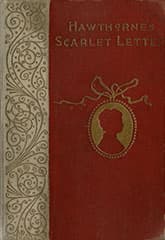The Scarlet Letter
Critique • Quotes
 1892 edition
1892 editionSubtitle
A Romance
First publication
1850
Literary form
Novel
Genre
Literary, historical fiction
Writing language
English
Author's country
United States
Length
Approx. 63,500 words
The dark passions of early America
Everyone knows the general story of The Scarlet Letter as referenced in the title. A young, married woman in an early American colony, Hester Prynne, becomes pregnant from an affair with a man she refuses to name, and is forced to wear the letter "A"—for adultery—the rest of her life.
Described like this, the novel seems to be an early feminist tale, enlisting us on the side of the marked woman who also has to fight in a harshly religious community to raise her daughter on her own, while the father of her child, and partner in her sin, remains respectable. It seems like a forerunner of novels of wronged and oppressed women like Thomas Hardy's Tess of the D'Urbervilles or, to jump ahead more than a century, Margaret Atwood's The Handmaid's Tale.
But the further you go into the story, the less clear is this theme, the more contradictory are the characters, the more arcane are the issues raised.
Hawthorne's focus is not so much on the affair, which is never explicated, or even on the injustice of the punishment. Hester accepts she has done wrong and tries to redeem herself through living a life of kindness and good deeds.
The author's interest rather is mainly in the psychological impact of the woman's stigmatization on all concerned, including her daughter and the men who had wronged her. Especially, her estranged husband and the man who shared her guilt go through stages of recrimination, shame, fear, revenge-seeking, and confession.
Not all of this is easy to follow. Some of the motivations of the characters in Puritan seventeenth-century Massachusetts are hard to understand now. They seem to be overly concerned with religious issues that are no longer fore in our communities, like the relative value of beliefs and acts, or of winning salvation through grace or good works. Is it what you do or what you believe that determines your eternal fate? Or, to be more nuanced, perhaps it's what you believe about what you do.
Don't be scared off
Much of this may be lost on a modern, secular reader. But we do gather that of all the characters wracked by sin in the novel, it is Hester who finds her way through the religious morass. After her good works are rejected by the Puritan community as a means to her redemption, she quietly rejects its orthodoxy and lives her private spiritual life based on her own moral terms.
As a novel of early America venerating dark passions, especially guilt over original sin, as part of the universal human condition, The Scarlet Letter is a surprisingly lighter read than you may expect, even fanciful at times. Don't let the long paragraphs and scarce dialogue scare you off. The writing is straightforward and engaging—very American—which may be why it's been a popular novel for so long, despite its complex religious and darkly psychological themes.
Most, but not all, editions of The Scarlet Letter include an introductory piece, "The Custom-House," presenting a multi-generational sketch of the Salem customs office based on Hawthorne's experience working there two centuries after the time of Hester Prynne's story, which may seem irrelevant to the rest of the novel. Hawthorn ties it in by outlining in this introduction some of his approach to writing what he calls "romances," such as what follows.
He also recounts in this introduction his purported discovery in the custom house of the historical manuscript on which the novel is based—all fictional, of course.
But if you find the going in this section two ponderous to get through, you have my permission to skip it and get right to the more involving story of Hester Prynne and the society that wouldn't forgive her.
— Eric
Critique • Quotes

